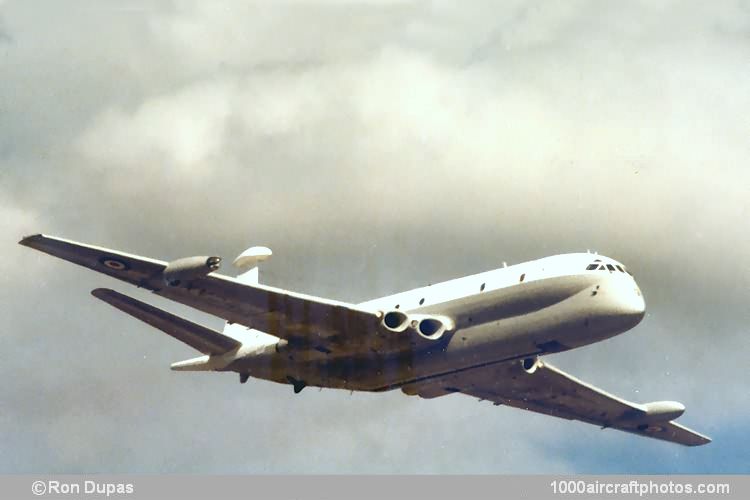RON DUPAS COLLECTION
No. 293. Hawker Siddeley HS.801 Nimrod MR.Mk.1 (XV247 c/n 8022) Royal Air Force
Photographed at Abbotsford, British Columbia, Canada, by Ron Dupas
07/31/2013. Remarks by
Johan Visschedijk: "The Nimrod was developed to replace the
Shackleton maritime reconnaissance aircraft of RAF Strike Command. Design of the Nimrod, as the Hawker Siddeley 801, began in June 1964, and government authority to proceed was announced in June 1965.
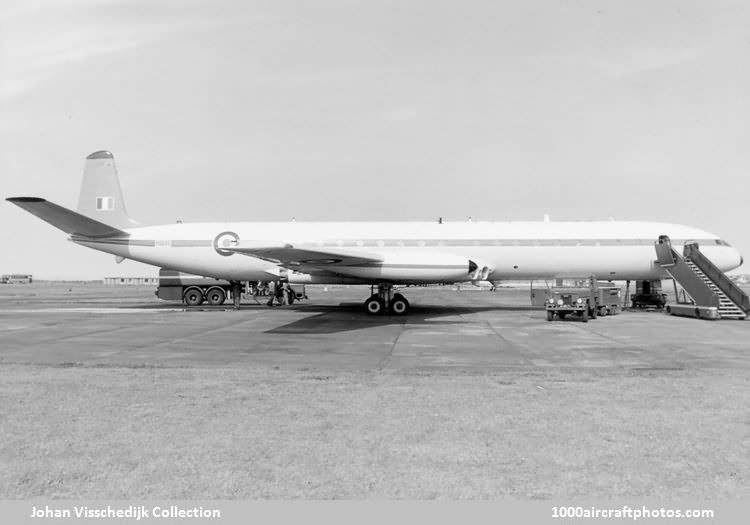
de Havilland D.H.106 Comet C.Mk.4 (XS235) (
Johan Visschedijk Collection)
Based substantially upon the airframe of the de Havilland D.H.106 Comet C.Mk.4, the Nimrod was a new production aircraft with a 6 ft 6 in (1.98 m) shorter, modified pressurized fuselage; an unpressurized, underslung pannier for operational equipment and weapons; and Rolls-Royce Spey turbofan engines (instead of the Avon turbojets of the Comet), with wider air intakes to allow for the greater mass flow.
Other external changes included enlarged flight deck main windows and 'eyebrow' windows; ESM and MAD equipment, in glass fiber fairings on top of the fin and in the tail boom respectively; and a searchlight in the starboard wing external fuel tank. The search radar was housed in a glass fiber fairing which forms the nose of the unpressurised lower fuselage.
The Nimrod was designed to combine the advantages of high altitude, fast transit speed with low wing loading and good low speed maneuvering capabilities when operating in its primary roles of anti-submarine warfare, surveillance and anti-shipping strike. When required, two of the four Spey engines could be shut down to extend endurance, and the aircraft could cruise and climb on only one engine. A wide range of weapons could be carried in the 48 ft 6 in (14.78 m) long bomb bay, and large numbers of sonobuoys and markers could be carried and released from the pressurized rear fuselage area.
In addition to its surveillance and anti-submarine warfare roles, the Nimrod could be used for day and night photography. As supplied originally to the RAF, the aircraft had a standoff surface missile capability. This was subsequently deleted but was reactivated on some aircraft during the Falklands campaign in 1982. The Nimrod MR.Mk.1 could carry sixteen additional personnel in the self-support role; the Nimrod MR.Mk.2 could carry only ten without the removal of equipment.
Two prototypes were built, utilizing existing Cornet 4C airframes. The first of these (XV148), fitted with Spey engines, flew for the first time on May 23, 1967 and was used for aerodynamic testing. The second (XV147) retained its original Avon engines, was first flown on July 31, 1967, and was used for development of the navigation/tactical system and special maritime equipment.
The following versions were produced:
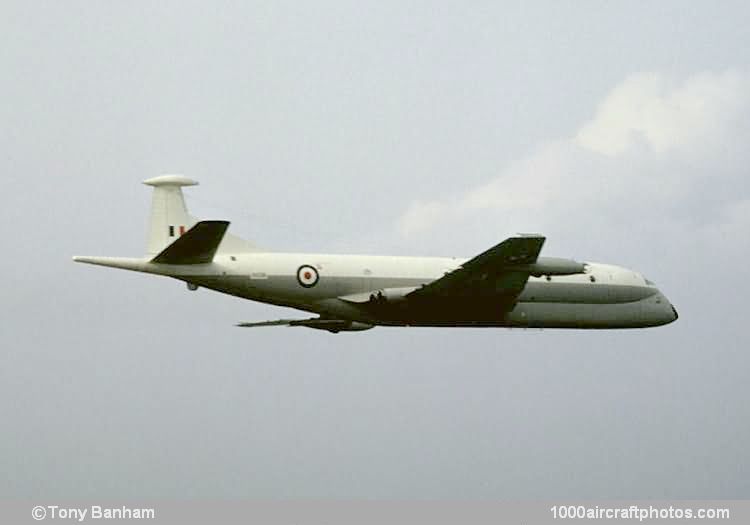
Hawker Siddeley HS.801 Nimrod MR.Mk.1 (XV229) (
Tony Banham Collection)
Nimrod MR.Mk.1. Initial production version, which was first flown on June 28, 1968, and forty-six were delivered (XV226 to XV263, XZ280 to XZ287). Later 35 were upgraded to Nimrod MR.Mk.2, while eleven were to be converted to Nimrod AEW.Mk.3s.
Nimrod R.Mk.1 and
Nimrod R.Mk.1P. Three aircraft (additional to the 46 Nimrod MR.Mk.1s ordered for RAF Strike Command) were delivered to No. 51 Squadron at RAF Wyton. These aircraft (XW664 to XW666), were employed for electronic intelligence (elint) missions, and could be identified by the absence of an MAD tail boom. XW664 was later fitted with a flight refueling probe and was designated Nimrod R.Mk.1P.
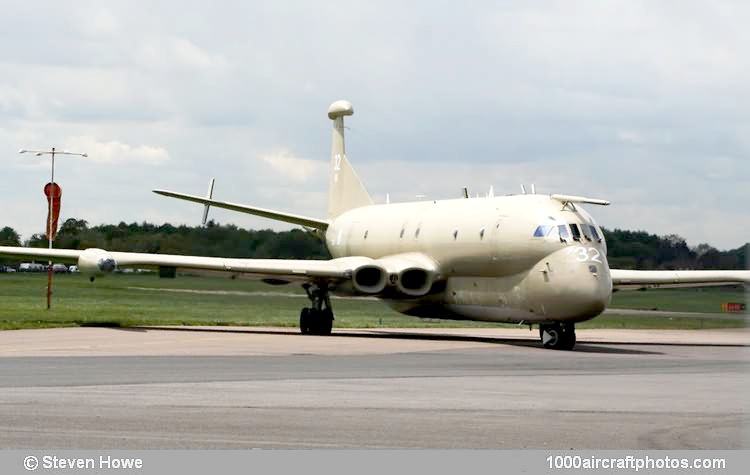
Hawker Siddeley HS.801 Nimrod MR.Mk.2P (XV232) (
Steven Howe Collection)
Nimrod MR.Mk.2 and
Nimrod MR.Mk.2P. Thirty-five RAF Nimrod MR.Mk.1s were refitted with new communications equipment; advanced tactical sensor, ESM and navigation systems; advanced search radar; new acoustic processing system, and Loral early warning support measures (EWSM) equipment in a pod at each wing tip. After refit these aircraft were redesignated Nimrod MR.Mk.2.
Aircraft deployed to Ascension Island during the spring 1982 Falklands campaign were fitted with Sidewinder air-to-air missiles for self-defense, and were given an attack capability with bombs, Sting Ray torpedoes and, later, Harpoon missiles. Air-to-air refueling probes were fitted at that time to sixteen aircraft (redesignated Nimrod MR.Mk.2P) making possible flights of up to nineteen hours with one additional pilot and navigator.
Provision for such probes, and Sidewinder and Harpoon missile installations, were subsequently made on all Nimrod MR.Mk.2 aircraft. Associated with these changes were an added ventral fin, small finlets above and below the tail plane on each side, and eleven vortex generators on the leading edge of each outer wing.
Nimrod AEW.Mk.3. This airborne early warning (AEW) version of the Nimrod was designed by Hawker Siddeley specifically for European defense. Eleven Nimrod MR.Mk.1s (XV259, XV261 to XV263, XZ280 to XZ283 and XZ285 to XZ287) were allocated for conversion to Nimrod AEW.Mk.3. Specifically designed radars were installed in the nose and tail, with only marginal effect on the aircraft's performance, only the fin height was increased by 3 ft (0.91 m) to retain the same level of directional stability.
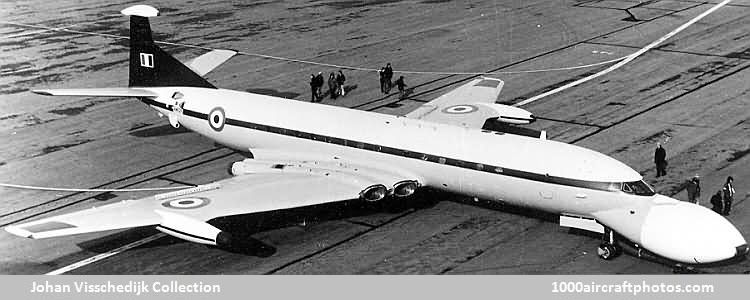
de Havilland D.H.106 Comet C.Mk.4 (XW626) (
Johan Visschedijk Collection)
Preceding the Nimrod AEW.Mk.3s was a converted Comet C.Mk.4C (XW626) with the nose radar fitted. This aircraft first flew June 28, 1977, and was used for communication trials; its part in the program was completed in October 1980.
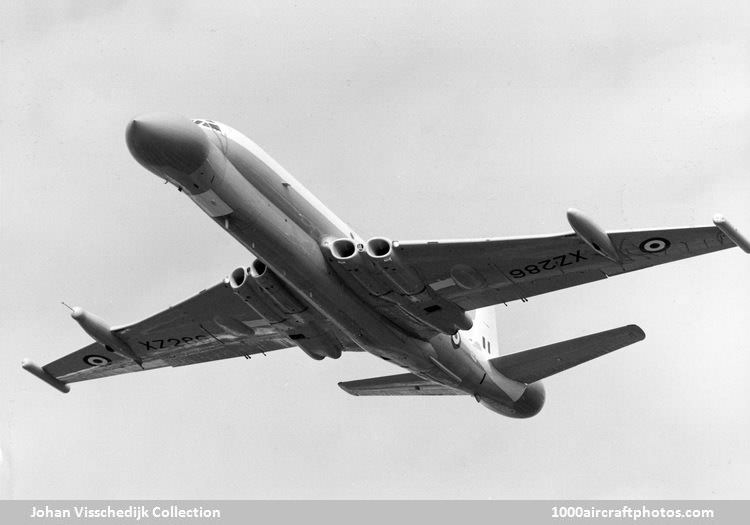
British Aerospace Nimrod AEW.Mk.3 (XZ286) (
Johan Visschedijk Collection)
The first aerodynamically representative Nimrod AEW.Mk.3 airframe was XZ286, it made its initial flight on July 16, 1980, and began service trails in 1982. The first production standard Nimrod AEW.Mk.3 was XZ285, which made its initial flight on March 9, 1982, subsequently followed by the remaining nine aircraft. However, continuing difficulties with the radar system resulted in the program being cancelled in December 1986, in 1987 seven Boeing Sentry AEW.Mk.1 were purchased instead.
Nimrod MR.Mk.4. Ordered in December 1996 as a replacement for the Nimrod MR.Mk.2, 21 Nimrod Mk.2 aircraft were to be rebuilt and fitted with complete new wings, new turbofan engines, as well as upgraded systems, avionics, weapons and equipment. For directional stability, small fins were fitted on and under the tail plane. The first development aircraft to fly was ZJ516 (new c/n PA-1) on August 26, 2004. The Nimrod MR.Mk.4 program was also troubled with technical problems, delays and cost overruns, hence this program was cancelled as well on October 19, 2010, after only three development and two production aircraft had flown. All five aircraft were scrapped in 2011."
Created 1998-2001
